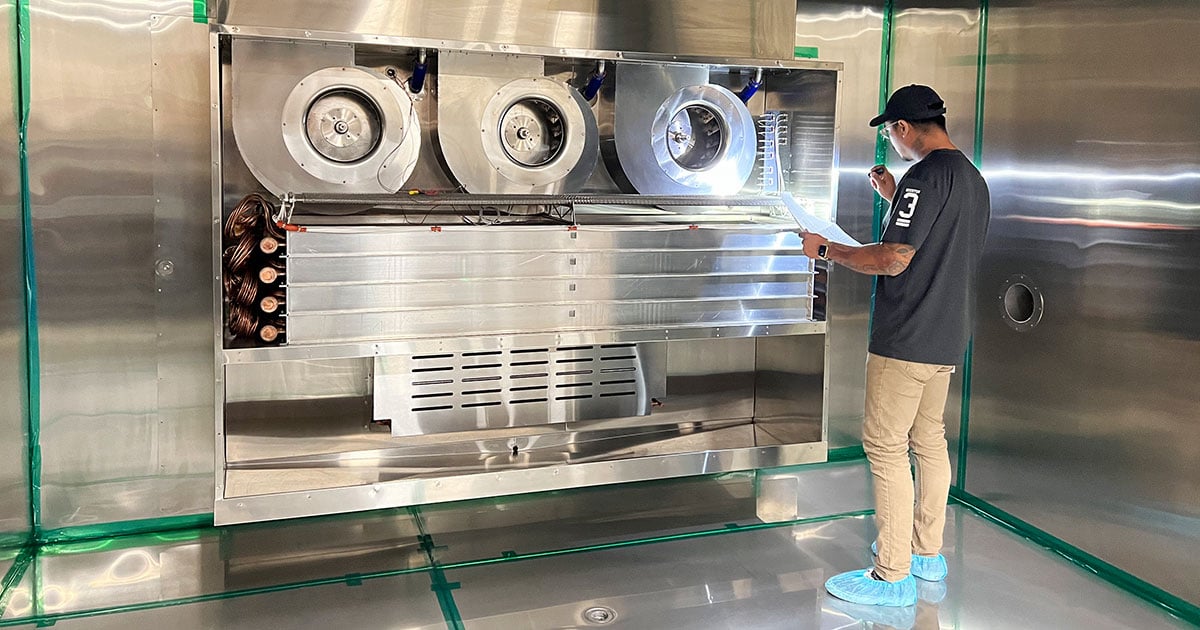Large Environmental Chamber: Size and Testing Considerations

Whether you require more space to properly test products or want to maximize the number of products you test at once, consider investing in a large environmental chamber.
Let’s look at what goes into identifying whether a large environmental chamber is right for you, including testing requirements, temperature characteristics, and chamber size.
Shopping for a Large Environmental Test Chamber
Large environmental chambers typically encompass floor models greater than 13 cubic feet in volume and all walk-in, or drive-in, chambers. Although that’s a wide range, manufacturers like Associated Environmental Systems make it easy to narrow your search.
AES’s product filter enables you to show options based on test type (such as temperature and humidity) and internal volume, in addition to other requirements including low temperature requirements, facility power, chamber style, and chamber series.
Notably, AES has standard floor models starting as small as 1 cubic foot in volume and up to 246 cubic feet. If your filter returns no options, you may require a custom chamber.
As you might imagine, the larger the chamber, the more expensive it will be, and custom and walk-in builds take additional production and engineering time. So plan accordingly.
Considerations for Large Chambers
If you have your eyes on a large environmental chamber, you need to evaluate several size considerations. These are discussion points to bring up with your manufacturer prior to making a purchase.
Product-to-Workspace Ratio
Typically, the suggested ratio in terms of product volume to chamber space is 1:3 to facilitate proper airflow during tests. This ratio applies to a single DUT as well as the total number in the load.
While 1:3 is a common ratio, more dense devices under testing (DUT) often require a much larger space to condition properly. Alternatively, less dense DUTs—for example, a chassis or other products with holes—require less space. Keep these considerations in mind as you identify the volume you’ll need.
Accommodating Live Loads
Many products require live-load testing. Some DUTs produce so much heat that a larger environmental chamber is necessary to dissipate it. This also impacts the chamber’s pull-down rates and humidity features.
Because active-load products produce so much more energy (in the form of heat), you may need not only a larger chamber but a more powerful refrigeration system to go with it.
Placement, Access, & Footprint
Customers sometimes overlook dimensions and access to appropriate power and water sources when they settle on a chamber.
AES, however, is proactive. Their engineers consider not only how the chambers fit in your lab, but also how to properly ship them. For instance, AES recently completed a large, tall chamber that required a low-bed truck for transportation. The chamber could be safely loaded while remaining low enough to clear power lines during transit.
The last thing you want is an expensive piece of machinery that won’t ship well or fit in your lab because its footprint is too large.
Weight
These chambers can challenge the weight capability of your lab or hallways, especially once the chamber is loaded.
AES’s casters are designed to hold up to 1800 pounds. Therefore, it’s important to be upfront about how much weight you plan to add to the chamber. The manufacturer can plan to add additional casters to accommodate heavier loads.
Identifying the Right Chamber for You
Sometimes you have no choice—you need a large or walk-in chamber. If you’re still in the consideration stage of the buying process, however, explore your options. You may find employing multiple smaller chambers, especially stackable models that maximize footprint, yields more efficient testing.
For instance, rather than test 100 DUTs at once in a large chamber, you might divide them into four smaller chambers, enabling you to test the same number at the same time while isolating potential defects within a single workspace.
This is based on getting efficient testing, influenced by LEAN manufacturing principles.
At the end of the day, large environmental chambers can facilitate testing vast quantities of DUTs simultaneously or accommodate high-volume products. However, before you purchase one, be certain it suits your testing requirements, temperature needs, and other spatial constraints.
It’s vital you consult an experienced test chamber manufacturer to help determine which chamber size is appropriate for you. They’ll go over all of these considerations and give you the confidence you have the right testing solution for your lab.
Associated Environmental Systems has been designing and manufacturing environmental test chambers for more than 60 years. Contact us today to learn more about which large chamber model best fits your testing needs.


